The rapid growth of eCommerce businesses can’t afford cart abandonment or downtime. During high-traffic events such as Black Friday, Cyber Monday, and major holiday sales, online retailers must ensure their platforms can withstand intense user demand.
Any type of disruption, from website downtime to slow performance, can result in significant revenue loss, frustrated customers, and long-term damage to brand credibility.
According to Baymard Institute, the average cart abandonment rate is around 70.19%, and even a single hour of downtime can cost large retailers over $1 million in lost sales and reputation damage.
This is where strategic DevOps practices come into play, providing the foundation to manage traffic surges and maintain optimal performance. By integrating development and operations, DevOps improves site reliability, performance, and the overall customer experience.
Here are 10 DevOps strategies for eCommerce with real-world DevOps examples that can be adopted to reduce cart abandonment and avoid costly downtime.
1. Adopt Cloud-Native Infrastructure for Scalability
Embracing cloud-native infrastructure is essential to achieving agility and scalability. Cloud providers such as AWS, Microsoft Azure, and Google Cloud empower businesses with on-demand computing power that adjusts automatically to fluctuating customer demand.
Key advantages include:
- Elastic Load Balancing (ELB): Spreads incoming traffic evenly across multiple servers to ensure smooth performance and prevent service interruptions.
- Auto-Scaling: Dynamically adjusts computing resources—adding or removing capacity based on real-time traffic patterns.
- Serverless Computing: Executes code without the need to manage servers, making it a perfect solution for variable workloads
Real-World Application: On Cyber Monday, a major online retailer utilized AWS Lambda to process millions of transactions in real time, mitigating infrastructure strain while maintaining a user experience.
Table of Contents
2. Use the Microservices Architecture
Unlike traditional monolithic systems, which bundle all functionalities into a single codebase, microservices architecture divides applications into small, independent services. Each service handles a specific function and can be scaled or updated without impacting the rest of the system to reduce website downtime, making it ideal for high-traffic eCommerce platforms.
Key advantages include:
- Scalability on Demand: Only scale the specific services that are under heavy load, such as checkout or payment, rather than the entire application.
- Resilient Performance: Failures are isolated to individual services, minimizing the risk of system-wide outages.
- Accelerated Development: Teams can build, test, and deploy updates to individual components more quickly, enabling continuous delivery.
Real-World Application: An e-commerce platform that separates its product listing, shopping cart, and payment gateway into distinct microservices can easily scale only the services experiencing spikes, such as checkout during a flash sale, to reduce cart abandonment without over-provisioning the entire system.
3. Implement Continuous Integration and Continuous Deployment (CI/CD)
CI/CD pipeline for eCommerce automates the process of building, testing, and deploying code, allowing these platforms to deliver updates faster and with fewer errors.
Key advantages include:
- Speed: Quickly roll out new features, bug fixes, or security patches.
- Stability: Automated testing catches issues before they reach customers.
- Reliability: Frequent, small deployments reduce the risk of major failures.
Real-World Example: Shopify uses CI/CD to deploy updates multiple times a day. This helps them improve performance, fix issues quickly, and keep the user experience smooth, even during peak shopping events.
4. Optimize Caching Mechanisms for Speed and Scalability
Caching helps reduce server strain and improves load times by storing frequently requested data closer to the user. When implemented correctly, caching allows your eCommerce site to handle high traffic smoothly and reduce cart abandonment without compromising performance.
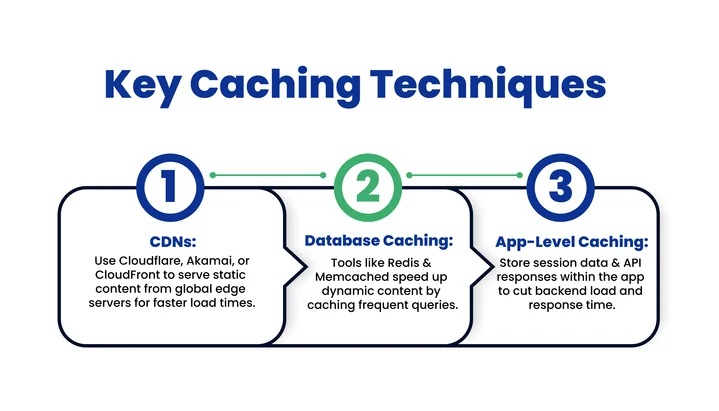
Real-World Example: Etsy, a large online marketplace, uses a combination of Redis and CDN caching to manage high volumes of user traffic during events like holiday sales. By offloading static content to edge servers and caching dynamic queries, Etsy maintains fast page loads even during traffic spikes.
Struggling with High Cart Abandonment Rates? Discover how the right eCommerce DevOps strategies can fix slow load times and system failures.
5. Monitor and Log Everything for Early Issue Detection
Real-time monitoring and centralized logging are critical to reduce website downtime and identify performance issues before they affect customers. Visibility into system behavior ensures faster incident response and long-term reliability.
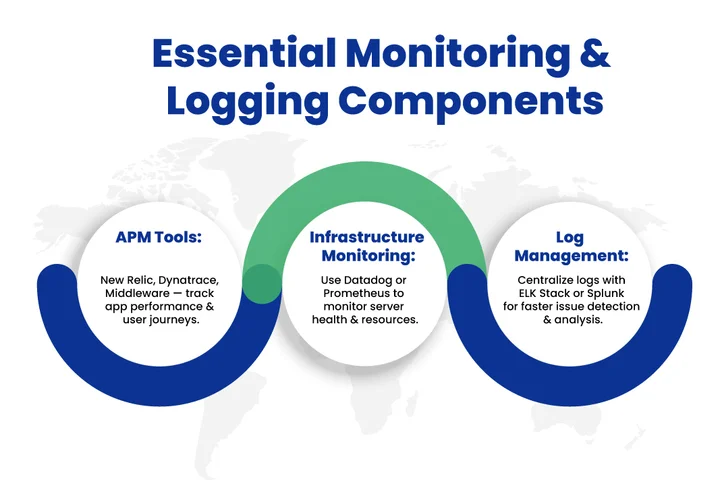
Real-World Example: Zalando, a leading fashion eCommerce company, uses Prometheus and ELK Stack to monitor its microservices architecture. Real-time alerts and detailed logging enable teams with eCommerce uptime monitoring to catch issues early and ensure system stability during peak sales events.
6. Prioritize Load Testing to Prevent Failures Under Pressure
Load testing helps simulate real-world traffic conditions to identify performance bottlenecks before they affect users. It ensures your eCommerce platform stays responsive and reduces cart abandonment, even during peak demand.
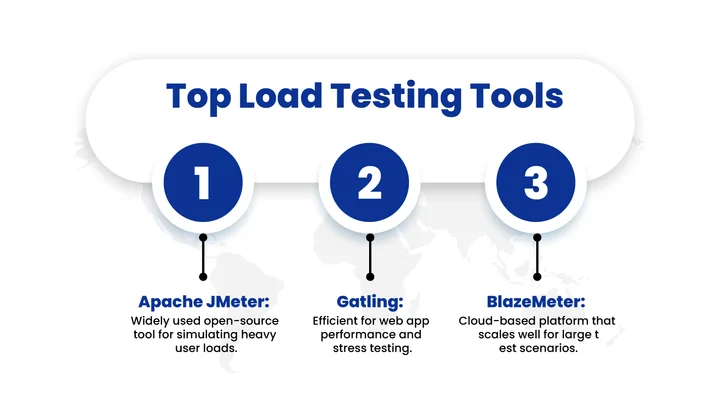
Real-World Example: Flipkart, one of India’s largest online retailers, uses load testing extensively before major events like Big Billion Days. By stress-testing its systems with simulated traffic spikes, Flipkart reduces website downtime to ensure platform stability and an enhanced user experience during massive sale periods.
7. Security Protocols to Protect Customer Trust
High-traffic shopping periods are prime targets for cyberattacks. A breach or DDoS attack during peak sales can cause major financial and reputational damage. Strengthening security measures ensures customer data stays safe and platforms remain online.
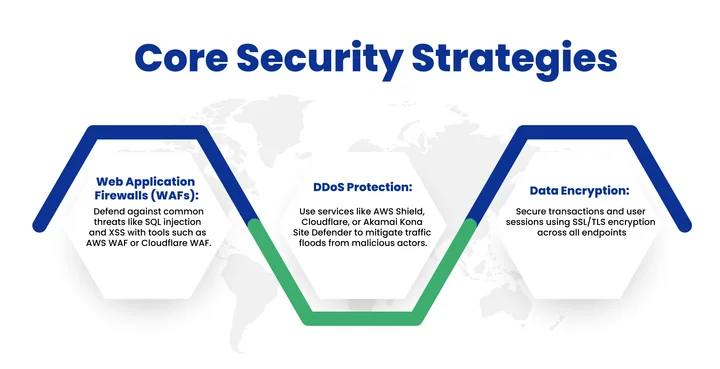
Real-world Examples: Target, a major U.S. retailer, integrates WAFs, DDoS protection, and encryption into its multi-layered defense strategy, helping prevent data breaches like the one in 2013 and reinforcing customer trust during high-traffic events like Black Friday.
Losing Customers to Slow Checkouts or Site Glitches? We implement DevOps strategies to keep your storefront fast, stable, and conversion-ready, no matter the traffic spike.
8. Adopt a DevOps Culture for Faster Innovation and Resilience
A strong DevOps culture is more than just using automation tools; it’s about fostering a mindset of shared responsibility, transparency, and continuous improvement across all teams involved in delivering your eCommerce platform. When development, operations, and QA teams collaborate seamlessly, especially with expert QA services, businesses can accelerate release cycles, detect issues early, and adapt swiftly to market demands.
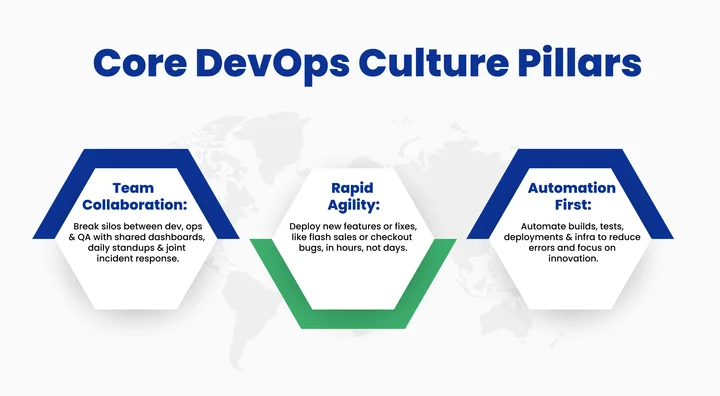
Real-World Example: Nationwide Insurance adopted a DevOps automation for online stores approach that includes its mainframe systems. By enabling continuous delivery pipelines that span both cloud and legacy infrastructure, they reduced deployment times from weeks to hours while maintaining regulatory compliance and operational stability.
9. Plan for Post-Peak Optimization to Prepare for What’s Next
The work doesn’t end when the holiday rush is over. Post-peak analysis is critical to understanding how your systems performed, where they struggled, and how to improve before the next traffic surge. This ensures you’re reacting as well as evolving continuously.
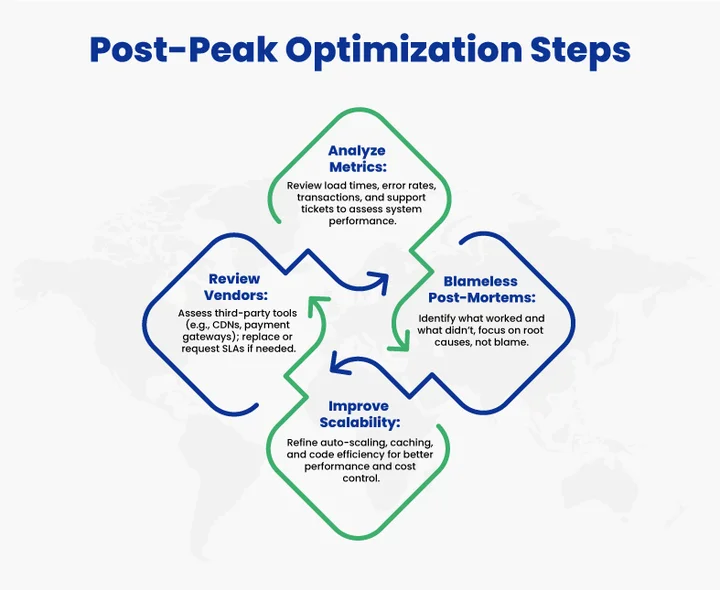
Real-World Example: Target, after every major sale season like Black Friday, conducts a multi-department review to evaluate systems, tools, and team coordination. They use this analysis to update infrastructure, improve app responsiveness, and revise their incident management protocols, ensuring they’re better prepared for the next surge.
10. Enable Continuous Monitoring & Real-Time Alerts
Real-time visibility into your system is essential to ensure high availability and responsiveness, especially during peak eCommerce periods. Continuous monitoring allows teams to detect anomalies early, while real-time alerts enable rapid incident response before customer experience is affected.
Key Monitoring & Alerting Tools:
- Prometheus + Grafana: An open-source combo for metrics collection and visualization. Prometheus scrapes system metrics, while Grafana provides customizable dashboards and alerting.
- Datadog: A comprehensive monitoring platform offering out-of-the-box integrations, log correlation, and AI-driven alerts across infrastructure, applications, and user experience.
- Amazon CloudWatch: Ideal for AWS-based solutions, CloudWatch provides performance insights and configurable alarms for resource thresholds or service errors.
Why It Matters:
- Early Detection: Identify and address issues like load spikes, increased latency, or payment gateway failures before users notice.
- Faster Recovery: Alerting systems trigger immediate action, reducing downtime and preventing revenue loss.
- Improved Customer Trust: A consistently reliable platform builds brand credibility and loyalty during critical shopping windows.
Real-World Example: During a major promotional event, an online retailer detected abnormal transaction failures via Datadog alerts tied to their payment gateway metrics. The operations team acted within minutes to roll back a faulty deployment, avoiding thousands in lost sales and customer dissatisfaction.
Frequently Asked Questions (FAQs)
How Can DevOps Help Prevent Cart Abandonment?
DevOps helps prevent cart abandonment by ensuring that online stores deliver fast, reliable, and enhanced user experiences. Through continuous performance monitoring, automated testing, and real-time issue resolution, DevOps minimizes slow load times, checkout errors, and crashes, common triggers for cart abandonment.
With CI/CD pipeline implementations, changes and improvements can be deployed quickly without disrupting user sessions. Additionally, auto-scaling infrastructure ensures consistent performance during traffic surges, keeping the checkout process smooth and frustration-free.
Which DevOps Tools for eCommerce can help reduce cart abandonment?
DevOps tools, such as Jenkins (for CI/CD), Selenium (for automated testing), Prometheus and Grafana (for performance monitoring), and Kubernetes (for scalable infrastructure), play a critical role in minimizing technical issues that lead to cart abandonment. These tools help ensure faster load times, bug-free deployments, real-time alerts, and high availability, creating a smooth and reliable shopping experience that keeps customers from leaving mid-purchase.
How Does Performance Optimization for Retail Websites Help Reduce Cart Abandonment?
Performance optimization for retail websites ensures faster load times, smoother navigation, and a reliable checkout experience, all of which are necessary in preventing cart abandonment. By employing DevOps practices such as continuous monitoring, load testing, and automated scaling, retailers can effectively manage high traffic without experiencing slowdowns or errors. A high-performing website keeps customers engaged and increases the likelihood of them completing their purchases.
Conclusion
Handling traffic surges during peak shopping seasons isn’t merely about staying online; it’s a strategic move to outperform the competition. With the DevOps best practices for eCommerce in place, including cloud-native infrastructure, microservices architecture, CI/CD automation, caching, load testing, and real-time monitoring, eCommerce businesses can deliver improved customer experiences, maintain uptime, and drive more revenue.
By integrating modern cloud-native tools and DevOps pipelines, businesses can reduce cart abandonment and maintain the reliability of legacy systems while gaining the agility needed in today’s digital marketplace.
Clustox specializes in helping eCommerce platforms implement these very strategies. We specialize in DevOps and enterprise modernization. With Clustox as your partner, you can confidently scale for peak seasons, improve performance, and future-proof your infrastructure.
Are you afraid of sales drops during traffic spikes? We specialize in implementing reliable DevOps strategies to make sure your customers never encounter a dead end at checkout.

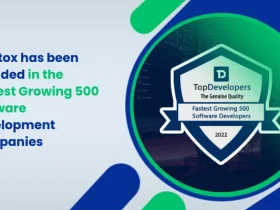


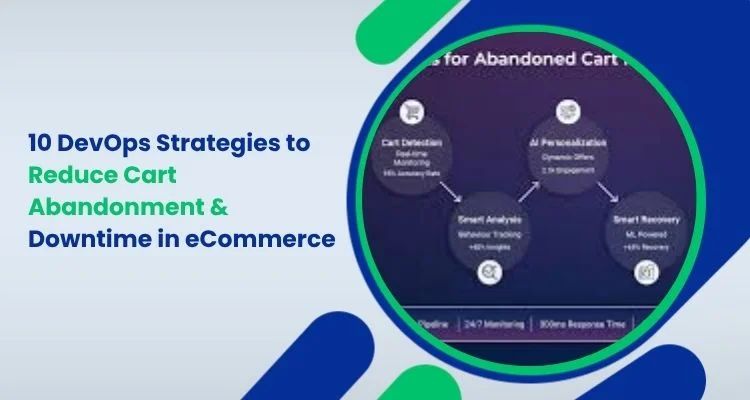
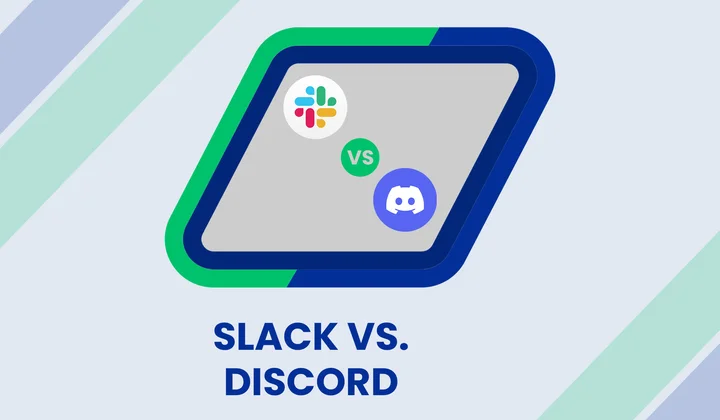

Share your thoughts about this blog!